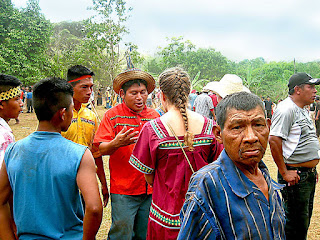
-East of David from the InterAmericana's San Felix turnoff, 43 miles/69 kilometers east of David, you can access Playa Las Lajas, one of Panama's most beautiful golden sand beaches; the semi-autonomous lands of Comarca Ngobe-Bugle. Even though some may have wanted an article about Las Lajas on this posting, I found San Felix much more interesting. How many of us who live in David or Boquete have really bothered to visit this town while we are visiting Las Lajas.
-San Felix is a district it's townships include Las Lajas (capital), Juay, San Félix, Lajas Adentro and Santa Cruz. It is the hub for the Ngäbe-Buglé they may receive healthcare aid, other resources, and their throughway out of the area. A great asset to this Comarca from what I noticed that day was the Jesuit charity organization serving the local & indigenous Ngobe-Bugle community of western Chiriqui with a Mission, School, Vocational Ed, Bakery, Subsistence Farming & Management, Handicraft Arts, Crisis Pregnancy Care, and Hotel/Domestic Education. Two workers at the Mission gave us a splendid tour of the grounds. 
-The Center receives donations to cover operating expenses; its director is Father Adonai Cortès. The Jesuits of the mission are part of the Nuestra Senora Del Camino in San Felix and in the 70’s it provided aid to the Ngäbe-Buglé to improve their life as well. In this area, the children lacked the economic resources, and so this internship closed. In September of 2004, implementation of a series of training courses to improve the productive capacity of the Comarca Ngäbe-Buglé in this area had developed.
The buildings that house the following training curses are spotless and very organized.
-The crafts center trains and promotes large-scale handicraft production and sale in the local and international market. As well as to developed entrepreneurship and business-management enabling them to generate new revenue and resources improving the quality of life for the women and their families. -A small bakery production building for training students on how to bake assorted breads, an assortment of desserts, food handling and control, teamwork, marketing and total quality. However, at the time of our visit the bakery’s bread mixer was not operating and in a repair shop in David.
-A small bakery production building for training students on how to bake assorted breads, an assortment of desserts, food handling and control, teamwork, marketing and total quality. However, at the time of our visit the bakery’s bread mixer was not operating and in a repair shop in David.
-The education and training center in San Felix’ parish has Hospedería Belén the focus high-risk pregnancy with special attention given to their patient’s condition and treatment. They have rooms for the patient stay, their husband, or mother, or other relative, or friend can stay with them as well. This initiative has helped to reduce the high rates of mortality for women at the time of delivery. 
-Agro forestry and self-sustaining farming is another training area providing their students with the necessary training tools. Educating them how to decrease the malnutrition rates, increase school performance of children and adolescents, through the implementation of agro forestry projects and self-sustaining farms that will improve their diet and consequently their economic status.
-They also have training in Computers, Basic English, Internet, Gardening, and Household Assistants. 
-Attached is a video regarding Ntra. Sra. Del Camino even though it is in Spanish you can see what the center looks like.
http://www.facebook.com/video/video.php?v=121310427077 
-We visited the beautiful Iglesia IHS (Catholic Church) located in the middle of town. The Iglesia IHS is new and has beautiful murals on the ceiling acknowledging the Ngäbe-Buglé.

In addition, a museum housing art pieces from the owner's grandduaghter made from miscellaneous items that he had collected. Instead of throwing away the scraps, he would make art pieces from them creating a great way to recycle. Something we have heard all our lives “ones man’s garbage is another man’s treasure.” I have included photos of a few of his art pieces.  The small museum is located across the street from La Iglesia IHS, there is no sign on the storefront but is next door to a grocery store.
The small museum is located across the street from La Iglesia IHS, there is no sign on the storefront but is next door to a grocery store.
-I suggest if you have not visited San Felix do so while staying in Las Lajas it merits a stop, although speaking some Spanish may be helpful.
EXPLORE.DREAM.DISCOVER




















